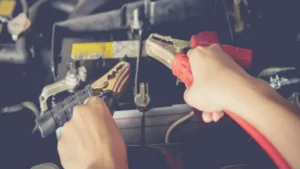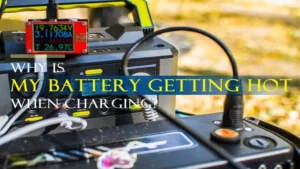We’ve all been there: you hop into your car, turn the key, and instead of revving to life, you’re met with silence. A dead car battery is never a welcome surprise, but with the right knowledge, you can quickly and easily jump-start your vehicle and get back on the road. Jump-starting a car battery involves using another vehicle’s battery to provide a jolt of energy to your own.
It may sound like a tricky process, but with the right tools and steps, it can be done in minutes. In this blog, we’ll detail everything you need to know about jump-starting a car battery. From identifying the type of battery you have to connecting the cables correctly, we’ll walk you through each step of the process.
By the end, you’ll have the confidence to tackle a dead battery head-on and get your car running again.
Introduction
Jump starting a car battery with a charger can be a lifesaver in a pinch. The process may seem intimidating if you’ve never done it before, but it’s actually relatively simple once you understand how to do it safely. First, ensure that your car battery charger is compatible with your car battery, and that your charger is in good working condition.
Then, make sure that both your car and the car providing the jump start are turned off. Connect the positive (red) cable to both car batteries’ positive terminals, and then attach one end of the negative (black) cable to the negative terminal of the working battery, and the other end to an unpainted metal surface on the car with the dead battery. Turn on the car providing the jump start and let it run for a few minutes.
Finally, try starting the car with the dead battery. If it doesn’t start, try waiting a bit longer or adjusting the connections on the cables. Remember to always wear safety goggles and work gloves when handling car batteries, and to consult your vehicle’s owner’s manual for additional guidance.
With these steps, you can confidently jump start your car battery using a charger!
Why do you need to jump-start?
Jump-starting your car is a necessary skill that every driver should have up their sleeve. Occasionally, even the best car batteries can fail, leaving you stranded in the middle of nowhere, and unable to start your engine. Jump-starting allows you to revive your car battery and start your engine again using someone else’s battery or a jump-starter kit.
It’s a quick and easy procedure that can save you a lot of frustration and stress. So, why do you need to jump-start? Jump-starting is crucial for drivers who get stuck with a dead battery, especially during emergencies, and it’s better to be prepared for such situations in advance.

What equipment do you need?
If you’re new to photography, deciding what equipment you need can be overwhelming. The truth is, the best camera and lenses for you will depend on your specific needs and preferences. However, there are a few basics that every beginner should consider.
Firstly, you’ll obviously need a camera. This could be a DSLR (digital single-lens reflex), mirrorless, or point-and-shoot camera. These days, even smartphones can take excellent photos, so if you’re on a tight budget, you might be able to get away with just using your phone.
Secondly, you’ll need a memory card to store your photos on, as well as a way to transfer them to your computer or other device. Additionally, investing in a tripod and a few different lenses, such as a zoom lens and a prime lens, can help you get more creative with your shots. It’s important to remember that while equipment is important, it’s not everything.
Learning some photography fundamentals and practicing regularly are just as crucial to improving your skills.
The Process
If your car battery is dead and you don’t want to call for a tow or wait for AAA, you can jump-start your car battery using a charger. The process is simple and straightforward, but you need to follow some basic steps to avoid any mishaps. First, connect the positive cable of the charger to the positive terminal of the dead battery, and the negative cable to the negative terminal.
Then, connect the other end of the charger cable to the running car’s battery, ensuring the clamps aren’t touching anything else. Start the car and let it run for 5-10 minutes, then turn it off and disconnect the cables in reverse order. You’re all set! It’s important to note that jumping a car battery can be dangerous if not done correctly, so always refer to your car manual for specific instructions and safety precautions.
Additionally, make sure that your charger is compatible with your car’s battery and that you don’t overcharge it. By following these steps, you can jump-start your car battery safely and efficiently using a charger.
Step 1: Safety Precautions
When it comes to any project involving electricity, safety should always be the first consideration. Before starting any electrical project, it is important to ensure that the power source is turned off. This may seem like common sense, but it is easy to overlook and can be extremely dangerous if overlooked.
Disconnect the power supply to the circuit, and use a voltage tester to confirm that there is no electricity flowing through the wires. Also, make sure to wear appropriate safety gear such as gloves and safety glasses to prevent any accidents. Taking these simple yet crucial steps can ensure that you complete your electrical project safely and without any incidents.
Remember, the main keyword here is safety, so always prioritize safety above everything else.
Step 2: Position the Booster Car
Now that you have turned off both cars, it’s time to position the booster car. Make sure that the two cars are facing each other with a distance of about one to two feet. The booster car should be close enough for the jumper cables to reach the dead battery of the other car.
Also, ensure that the booster car has its handbrake engaged and is in park or neutral. If there is only one person with you, it may be challenging to position both cars correctly. In this case, it’s advisable to ask for someone’s help to avoid any unnecessary accidents.
Additionally, try to park on a flat surface that is free from any obstructions to avoid any unwanted accidents. Remember, the goal is to complete the jump-start process safely and correctly. By positioning the two cars correctly, you’re setting yourself up for success.
Step 3: Connect the Jumper Cables
Now that you have positioned your vehicles correctly, the next step is to connect the jumper cables. First, take the red cable and attach one end to the positive (+) terminal of the dead battery. Then, connect the other end to the positive (+) terminal of the working battery.
After that, take the black cable and attach one end to the negative (-) terminal of the working battery. But instead of attaching the other end to the negative (-) terminal of the dead battery, find an unpainted metal surface in the engine compartment of the dead vehicle and attach the cable there. This is because attaching it directly to the negative terminal of the dead battery can cause hydrogen gas to build up and ignite.
Once everything is securely connected, start the engine of the working vehicle and let it run for a few minutes. Then, try starting the engine of the dead vehicle. If it starts, disconnect the cables in reverse order – black from the previously grounded metal surface, black from the working battery, red from the working battery, and lastly red from the dead battery.
Remember to drive the revived vehicle around for at least 20 minutes to allow the alternator to recharge the battery fully.
Step 4: Start the Booster Car
Now that you’ve connected the jumper cables to both vehicles, it’s time to start the booster car. Before doing so, make sure the key is in the ignition and turned to the off position. Then, start the booster car and let it run for a few minutes.
This allows the battery to charge, ensuring that there’s enough power to start the dead car. While the booster car is running, keep an eye on the engine temperature gauge to prevent overheating. If the temperature rises above the normal range, turn off the booster car and wait for it to cool down before trying to jump start the other vehicle.
Remember, you should never leave the booster car unattended while it’s running. Once the booster car has been running for a few minutes, turn off the engine and proceed with starting the dead car. With a bit of luck, the engine should start up easily, and you’ll be back on the road in no time.
Just don’t forget to disconnect the jumper cables in the reverse order of how you connected them.
Step 5: Attempt to Start the Dead Car
Now that you’ve connected the two cars, it’s time to attempt to start the dead car. First, double-check that both cars are in park or neutral and that all accessories and lights are turned off. Then, start the engine of the working car and let it run for a few minutes to charge up the dead car’s battery.
Next, try to start the dead car. If it doesn’t start immediately, give it a few more minutes to charge up before trying again. However, if it still doesn’t start after a few attempts, there may be other issues besides a dead battery and you’ll need to seek professional help.
Remember, safety always comes first – be sure to disconnect the cables carefully and in the correct order once you’re finished. With a little patience and effort, jump-starting a dead car can be a breeze and get you back on the road in no time!
Tips and Tricks
If you find yourself stranded with a dead battery, don’t panic, because jump starting your car battery charger is actually quite simple. The first step is to locate a working car to use as a donor vehicle. Park the working car next to the dead car and turn off both engines.
Attach one end of the red jumper cable to the positive terminal of the working car’s battery and the other end to the positive terminal of the dead car’s battery. Next, attach one end of the black jumper cable to the negative terminal of the working car’s battery and the other end to an unpainted metal surface on the engine block of the dead car. Finally, start the working car and let it run for a few minutes before attempting to start the dead car.
If it still won’t start, try leaving the working car running for a longer period of time to allow the dead car battery to charge. Remember to remove the cables in the reverse order that you attached them, and to drive the dead car for at least 30 minutes to ensure the battery is fully charged. With these simple tips and tricks, you can easily jump start your car battery charger and get back on the road.
What to do if the Dead Car Won’t Start?
Dead Car Won’t Start When your car won’t start, it can be frustrating and worrisome, especially if you are in a hurry or caught in the middle of nowhere. But before you panic and start calling for assistance, there are a few things you can do to try and jumpstart your car and get it running again. First, check the connections of your battery, starting with the negative terminal and making sure it’s tight.
Next, try jumpstarting your car with jumper cables and a good battery from another vehicle. If that doesn’t work, check the fuses and replace the dead one if needed. Another helpful tip is to turn off any electrical accessories, such as the headlights or radio, to conserve the battery’s remaining power.
If none of these tricks works, it may be time to call for a tow or professional mechanic to diagnose and fix the problem. Remember, taking proper care of your car’s battery and electrical system can help prevent future breakdowns and keep you on the road.
How to Keep Your Battery from Dying Again?
One of the most frustrating things to deal with is a dying battery on your phone or laptop. It can be especially aggravating if you’re out and need to make a call or check an important message. Luckily, there are some tips and tricks you can use to keep your battery from dying again.
One way is to lower the brightness on your screen. This can significantly extend the life of your battery. Another option is to turn off unnecessary apps and services.
Several apps can run in the background, draining your battery without you even realizing it. Likewise, minimizing your usage of power-hungry apps and features like GPS and Bluetooth can also help save your battery life. Finally, investing in a portable battery pack or carrying a charging cable with you can provide backup power and prevent emergencies.
Taking care of your battery doesn’t have to be complicated, and these simple tricks can ensure that you’re never left without your phone or laptop when you need it most.
Conclusion
In conclusion, jump starting a car battery charger is like performing CPR on your vehicle – it requires a jolt of energy to bring it back to life. Just like how we rely on electricity to power our lives, our cars also rely on it to get us from point A to point B. So, if your car battery is flatlining, don’t panic.
Just remember to connect the positive and negative cables properly, wait a few minutes, and give your car the juice it needs to revitalize. And who knows, maybe you’ll even impress your friends with your newfound jumper cable skills. Happy jump starting!”
FAQs
What is a jump start car battery charger?
A jump start car battery charger is a device used to provide a boost of power to a car battery that has lost its charge and cannot start the engine.
How does a jump start car battery charger work?
A jump start car battery charger works by sending a surge of power to the car battery, which provides enough energy to start the engine.
Can you use a jump start car battery charger on any type of car?
Yes, you can use a jump start car battery charger on any type of car, as long as the voltage of the device matches that of the car battery.
How long does it take to jump start a car battery with a charger?
The time it takes to jump start a car battery with a charger depends on the size of the battery and the capacity of the charger. It can take anywhere from a few minutes to several hours.
Is jump starting a car battery with a charger safe?
Yes, jump starting a car battery with a charger is safe as long as you follow the instructions provided with the device and take precautions to avoid electrical shock.
Can a jump start car battery charger damage your car battery?
Yes, if the charger is not used properly, it can damage your car battery by overcharging or undercharging it.
How often should you use a jump start car battery charger?
You should only use a jump start car battery charger when your car battery is low and needs a boost. It is not recommended to use it regularly as it can reduce the overall life span of your car battery.








